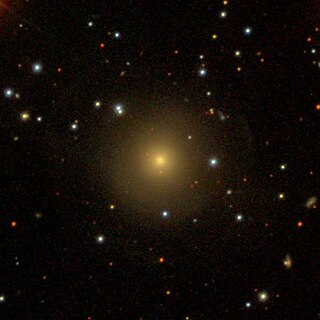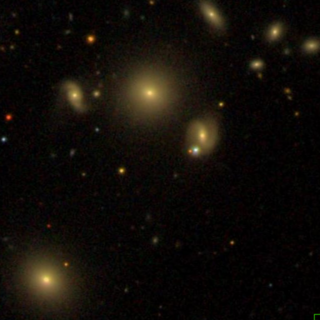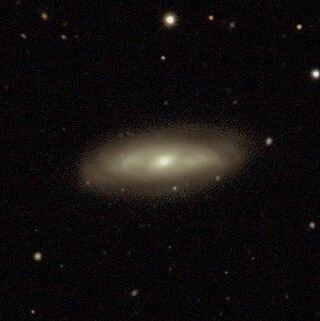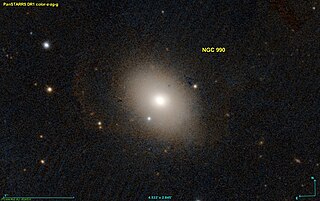
NGC 7315 is a lenticular galaxy in the constellation of Pegasus. It was discovered on 11 September 1872 by Édouard Stephan. It was described as "very faint, extremely small, round, brighter middle" by John Louis Emil Dreyer, the compiler of the New General Catalogue.

NGC 3554 is an elliptical galaxy in the constellation Ursa Major. It was discovered in December 1827 by John Herschel.

NGC 3258 is an elliptical galaxy in the constellation Antlia. It is a member of the Antlia Cluster, which lies about 40.7 megaparsecs away. It was discovered on May 2, 1834 by John Herschel.

NGC 1728 is a spiral galaxy in the constellation Eridanus. The galaxy is listed in the New General Catalogue. It was discovered on November 10, 1885 by the astronomer Edward Emerson Barnard.

NGC 159 is a barred lenticular galaxy in the constellation Phoenix. The galaxy was discovered on October 28, 1834, by John Frederick William Herschel.

NGC 1077 is a spiral galaxy in the constellation Perseus. It was discovered on 16 August 1886 by Lewis A. Swift. It was described as "very faint, pretty large, extended" by John Louis Emil Dreyer, the compiler of the New General Catalogue.

NGC 5559 is a barred spiral galaxy, located 240 million light-years away in the constellation of Boötes. It was discovered on April 10, 1785 by the astronomer William Herschel.

NGC 1683 is a spiral galaxy in the constellation Orion. The object was discovered in 1850 by the Irish astronomer William Parsons.

NGC 740 is a barred spiral galaxy located in the Triangulum constellation. It is estimated to be 210 million light-years from the Milky Way and has a diameter of about 85,000 light-years. It was discovered by the Irish engineer Bindon Stoney, an assistant to William Parsons.

NGC 990 is an elliptical galaxy located in the constellation Aries about 153 million light-years from the Milky Way. It was discovered by the German - British astronomer William Herschel in 1786.

NGC 670 is a lenticular galaxy located in the Triangulum constellation about 165 million light years from the Milky Way. It was discovered by the German-British astronomer William Herschel in 1786.

NGC 790 is a lenticular galaxy in the constellation Cetus. It is estimated to be 233 million light-years from the Milky Way and has a diameter of approximately 90,000 light years. NGC 790 was discovered on September 10, 1785 by the German-British astronomer William Herschel.

NGC 904 is an elliptical galaxy in the constellation Aries. It is estimated to be 244 million light years from the Milky Way and has a diameter of approximately 85,000 ly. NGC 904 was discovered on 13 December 1884 by the astronomer Edouard Stephan.

NGC 906 is a barred spiral galaxy in the constellation Andromeda in the northern sky. It is estimated to be 215 million light years from the Milky Way and has a diameter of approximately 110,000 ly. NGC 906 was discovered on October 30, 1878 by astronomer Édouard Stephan.

NGC 804 is a lenticular galaxy located in the Triangulum constellation about 231 million light-years from the Milky Way. It was discovered by the American astronomer Lewis Swift in 1885. This galaxy was also observed by the French astronomer Guillaume Bigourdan on December 24, 1897, and it has been added to the Index Catalogue under the symbol IC 1773.

NGC 531 is a barred spiral galaxy in the constellation Andromeda with a visual magnitude of 10.51. It is a distance of 65.7 Mpc from the Sun. It is a member of the Hickson Compact Group HCG 10, and is interacting with the other members of the group.

NGC 736 is an elliptical galaxy in the constellation Triangulum. It is an estimated 200 million light years from the Milky Way and has a diameter of approximately 85,000 light years. NGC 736 was discovered on September 12, 1784 by the German-British astronomer William Herschel.

NGC 766 is an elliptical galaxy located in the Pisces constellation about 362 million light years from the Milky Way. It was discovered by British astronomer John Herschel in 1828.

NGC 623 is a large elliptical galaxy located in the Sculptor constellation at a distance of about 400 million light-years away from the Milky Way. It was discovered by British astronomer John Herschel in 1837.

NGC 861 is a spiral galaxy in the constellation Triangulum. It is estimated to be 360 million light-years from the Milky Way and has a diameter of approximately 165,000 light-years. The object was discovered on September 18, 1865 by Heinrich d'Arrest.




















